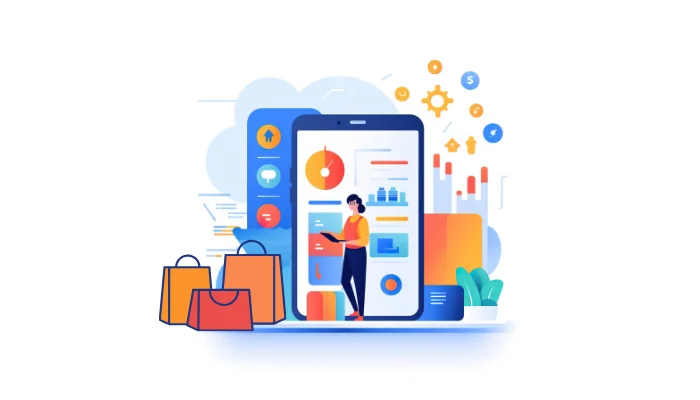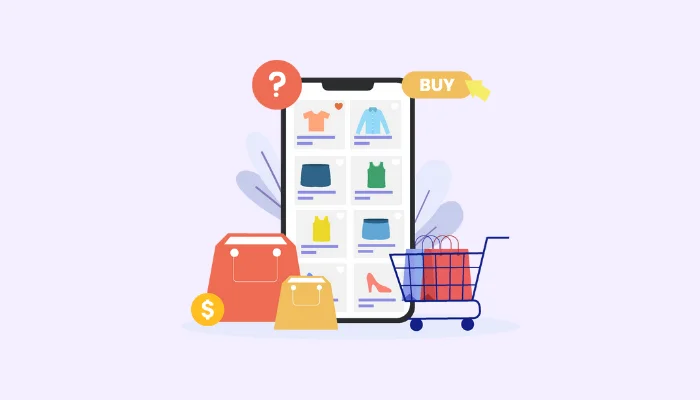People love shopping! And in the age of mobile commerce (& eCommerce), shopping apps are a treasure chest.
From Amazon to Sephora, mobile shopping trends are helping these commercial companies make billions and even trillions.
This has inspired a lot of retail businesses, wanting to create a shopping app of their own. If you are one of them, this blog is for you. Here, we shall be discussing all you need to know about shopping app development process, cost, feature, and so much more.
So with this being said, let’s get right into it, starting with:
Market For Shopping Apps: Statistics

So, before we get into the entire online shopping app development scene, let’s first look at some related market statistics:
- Ecommerce app revenue reached $4.02 trillion revenue in 2022, a 12% increase on the previous year
- About 10% of global ecommerce was conducted in the US, behind just China in total spend
- 4% of total retail in the US came from mobile ecommerce in 2021. In the UK, that figure was 15.8%
- Amazon was the most popular ecommerce retailer in the US and India in 2021
- Downloads and usage of ecommerce apps have grown over the past two years, with significant growth during the coronavirus pandemic
What is A Shopping App?

To understand shopping app development, one must understand what a shopping app is.
A shopping app is your ultimate digital companion, transforming the way you shop with unparalleled convenience and efficiency.
As an excellent example of mobile app development, the solution is seamlessly accessible on your smartphone or tablet. In addition, the innovative application allows you to explore a vast array of products and services at your fingertips.
With user-friendly interfaces and intuitive navigation, shopping apps offer a personalized experience tailored to your preferences.
Whether you’re hunting for trendy fashion items, cutting-edge gadgets, or household essentials, a shopping app provides a diverse marketplace where you can compare prices, read customer reviews, and make well-informed purchasing decisions.
Types of Shopping Apps |
|
| Category | Example Apps |
| E-commerce | Amazon, eBay, Alibaba |
| Fashion | Zara, ASOS, Fashion Nova |
| Grocery | Instacart, Walmart Grocery |
| Electronics | Best Buy, Newegg, Apple Store |
| Local Market | Craigslist, Facebook Marketplace |
| Food Delivery | Uber Eats, DoorDash, Grubhub |
| Specialty | Etsy (handmade crafts), Sephora (cosmetics) |
| Discount/Coupons | Groupon, RetailMeNot |
| Auction | eBay, Heritage Auctions |
| Second-hand | Poshmark, ThredUp, Depop |
| Subscription Box | Birchbox, Blue Apron |
Moreover, these apps often feature exclusive deals, discounts, and notifications, ensuring you never miss out on fantastic offers.
What sets shopping apps apart is their secure payment gateways, guaranteeing a safe transaction process.
You can track your orders in real-time and receive timely updates on delivery status, enhancing your overall shopping experience.
Plus, the convenience of doorstep deliveries saves you valuable time and effort.
Moving on, shopping app development is often also known as eCommerce app development or mobile commerce app development.
Best Shopping Apps in the Market Today

When it comes to shopping in the digital age, you deserve the best, and these top shopping apps in the market today deliver just that for you.
And if you are someone who wants to create a shopping app of your own, it’s highly recommended that you go through these apps, learning from the best.
Therefore, these are, as mentioned below:
- Amazon
- eBay
- Walmart
- Etsy
- Zara
- Sephora
- AliExpress
Moving on, it’s time to look at the reasons to go for shopping app development in the section below.
Reasons To Develop A Shopping App

So, why should you hire mobile app developers and invest in mobile shopping app development?
Well, there are a range of reasons to do so.
In this blog, we shall be discussing some of the best motivations behind shopping mobile app development.
1. Enhanced User Experience
The very first reason is better user experience.
There are alot of shopping platform, but not all of them are successful. And the main reason behind it is, poor UX.
With a shopping app for your own business, you can deliver seamless, user-friendly interface tailored for your customers.
And helps youe ensure they enjoy a smooth browsing and purchasing process.
2. Increased Sales
Well, well, who doesn’t want their sales to improve year-on-year? Everyone does.
And that’s one of the big reasons retail businesses create a shopping app. With the mobile application reaching millions of people, you can gather more orders.
In addition to this, the app allows the business i.e. you to target specific userbase.
3. Brand Loyalty
Every brand want loyal customers and this is partly why they are willing to invest so much in shopping app development.
In easy words, by offering a dedicated app fosters a sense of loyalty among your customers. And this helps keep your brand in their minds.
Thus, encouraging repeat business and positive reviews.
4. Competitive Edge
This is a big one!
There are alot of retail businesses. And all of them are your competition. Now to scale above them, there’s one thing that you can do, develop an app.
With a shopping mobile application of your own, you can gain competitive advantage and become the next big name in the field.
5. Secured Transactions
Lastly, we have one of the biggest reasons to do so is, secure transactions. Apps provide secure payment gateways, building trust among your customers.
With encrypted transactions, you offer a safe shopping environment, encouraging more sales.
Essential Features For Mobile Shopping App |
|
| User Reviews | Allow users to rate and write reviews for products. |
| Product Recommendations | Implement algorithms for personalized product suggestions. |
| Multi-Language Support | Support multiple languages for a diverse user base. |
| Order History | Enable users to view their past orders and reorder items. |
| Barcode Scanner | Allow users to scan product barcodes for quick searches. |
| Discount Coupons | Integrate a coupon system for discounts on specific items. |
| Favorites/Bookmarking | Let users save favorite products for quick access. |
| Shipping Options | Offer various shipping methods and delivery timeframes. |
| Multi-platform Support | Develop apps for both Android and iOS platforms. |
| In-App Messaging | Allow buyers and sellers to communicate within the app. |
| Advanced Search Filters | Include filters for color, brand, ratings, etc. |
| Product Comparisons | Enable users to compare prices and features of products. |
| Social Login | Allow users to sign up/login using social media accounts. |
| Push Notifications Customization | Let users choose notification preferences. |
| Augmented Reality (AR) | Implement AR features for virtual product try-ons. |
How To Develop A Shopping App, Entire Process

How To Develop A Shopping App, Entire Process
So, it’s time to learn how to develop a shopping app.
The process is simple enough if you know the step-by-step process. In this section of the blog, we shall be taking you through these steps to develop online shopping app.
Therefore, let’s get right into it:
1. Market Research
First you need to understand your target audience, competitors, and their app features. For this, the you need to identify trends and unique selling points to stand out in the market.
Once market research is done, it’s time to move to next step where we shall define features.
2. Define Features
Now that we have market research, it’s time to define features.
Speaking of features, we have already discussed some of the top features that you should include in your app. Therefore, with this being said, we move to choosing a platform.
3. Choose the Right Platform
When it comes to mobile app development, there are a few paths that you can take.
For instance:
- Android App Development
- iOS App Development
- Hybrid App Development
Apart from the platform, you also have to select development tools used in the process.
4. Design the User Interface (UI)
It’s time to design the app.
It is in this part where. shopping app developers will work on an intuitive, visually appealing design. It’s essential for you app’s UI should be easy to navigate.
Thus, ensuring a pleasant shopping experience.
5. Shopping App Development
With designing done, it’s time to create a shopping app.
In this step, we do the heavy lifting i.e. coding. This process is quite resource consuming and also takes alot of time. However, Done right, it can be very benefical to you in the long run since all of the important parts of the app are crated in this step.
Speaking of which, let’s move to the next step.
7. Payment Gateway Integration
We need to integrate secure payment gateways like PayPal, Stripe, or others based on your target market.
These will allow the user to make payment on your shopping app.
8. Testing
Before we deploy the app, we have to test it. And that’s exactly what we do in this section of the blog. Here, we conduct rigorous testing to identify and fix bugs.
In addition to this, the team will also perform usability testing to ensure the app functions smoothly on various devices and screen sizes.
10. Launch
It’s time to publish your app on app stores. For that, we create a compelling description, high-quality visuals, and engaging promotional materials.
Moreover, you can utilize social media, influencers, and app store optimization (ASO) techniques for visibility.
With this, we are done with the shopping app development process. And with this out of the way, let’s move to the cost part.
Shopping App Development Cost
So, how much does it cost to build a shopping app?
Well, online shopping app development cost can range from $15,000 to $55,000. All of this depends on the different factors involved in the shopping app development project.
Therefore, if you are looking for a closer estimate, we highly recommend that you consult online Shopping App Development Company who will help you with the same.
FAQ
Shopping app costs depend on features, design complexity, platforms, development team, backend infrastructure, security, testing, support, legal compliance, and marketing efforts.
To optimize your budget, prioritize essential features, choose a reliable development team, focus on user-friendly design, and invest in effective marketing strategies.
Security ensures safe transactions and protects user data. Implementing robust measures builds trust and safeguards your app against potential threats and cyberattacks.
Allocate funds for regular app updates, bug fixes, customer support, and ongoing marketing efforts. Post-launch support ensures your app stays functional, secure, and user-friendly.
ASO enhances your app’s visibility in app stores. Optimized app titles, descriptions, keywords, and visuals increase your app’s chances of being discovered by potential users.

Niketan Sharma is the CTO of Nimble AppGenie, a prominent website and mobile app development company in the USA that is delivering excellence with a commitment to boosting business growth & maximizing customer satisfaction. He is a highly motivated individual who helps SMEs and startups grow in this dynamic market with the latest technology and innovation.
Table of Contents




No Comments
Comments are closed.